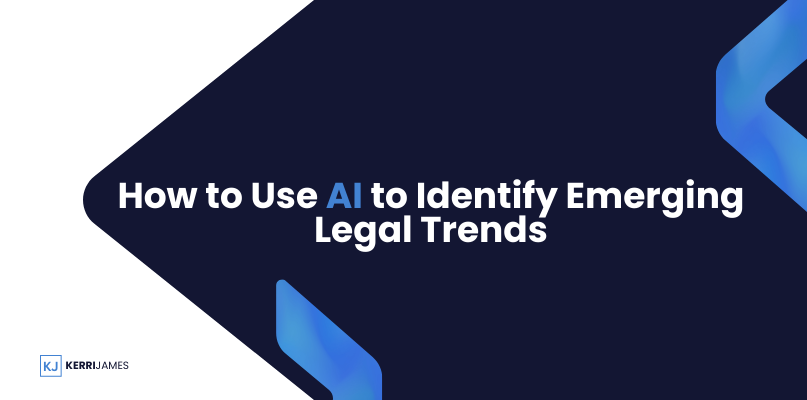The legal industry is in the midst of a profound transformation. From regulatory changes and new legislation to evolving societal norms and technological advancements, the landscape is shifting rapidly. In such a dynamic environment, staying ahead of emerging legal trends is not just beneficial—it’s essential. For legal professionals, the ability to anticipate and adapt to these changes can provide a significant competitive advantage, enabling better decision-making, improved client service, and more strategic planning.
Enter Artificial Intelligence (AI). Once considered a futuristic concept, AI is now a powerful tool being integrated into various industries, and the legal field is no exception. AI’s ability to analyze vast amounts of data, identify patterns, and predict future trends is revolutionizing how legal professionals operate. This blog post will explore how AI can be leveraged to identify emerging legal trends, offering practical insights and real-world applications.
The Importance of Identifying Emerging Legal Trends
In an industry where the stakes are high and the rules constantly evolving, identifying emerging legal trends is crucial. Legal trends encompass a wide range of changes, from new legislation and case law developments to shifts in client expectations and technological advancements. Understanding these trends allows law firms and legal departments to anticipate challenges, seize opportunities, and stay competitive.
Changing Legal Landscape:
The legal landscape is continuously evolving, influenced by numerous factors such as technological innovation, economic shifts, and social change. For instance, the rise of digital assets and cryptocurrencies has created new legal challenges and opportunities in areas like intellectual property and financial regulation. Similarly, increased focus on data privacy has led to new laws and regulations, such as the General Data Protection Regulation (GDPR) in Europe and the California Consumer Privacy Act (CCPA) in the United States.
Competitive Advantage:
Being at the forefront of these changes gives law firms and legal departments a competitive edge. It allows them to offer proactive advice to clients, mitigate risks before they escalate, and capitalize on new areas of legal practice. For example, firms that recognized the significance of data privacy early on were able to establish themselves as leaders in this field, attracting clients seeking expertise in navigating complex regulatory environments.
Challenges Without AI:
Traditionally, identifying legal trends has been a labor-intensive process, relying on manual research, monitoring of legal publications, and extensive analysis of case law. This approach is not only time-consuming but also prone to human error and bias. The sheer volume of information that needs to be processed makes it difficult to stay on top of all the relevant developments, particularly in a globalized world where legal changes can occur rapidly across different jurisdictions.
How AI Can Be Leveraged to Identify Legal Trends
Artificial Intelligence offers a solution to these challenges by automating the process of trend identification and analysis. AI can sift through vast amounts of data at unprecedented speeds, identifying patterns and making connections that might not be immediately apparent to human researchers. Here’s how AI can be utilized to identify emerging legal trends:
Data Analysis at Scale:
One of the most significant advantages of AI is its ability to analyze large datasets quickly and efficiently. Legal databases contain millions of case laws, statutes, regulations, and legal opinions. AI can process this data, identifying patterns and trends that would be impossible to discern manually. For example, AI can analyze case law to determine how certain legal principles are evolving over time, identifying shifts in judicial interpretation that may signal a new trend.
Predictive Analytics:
AI’s predictive capabilities are particularly valuable in trend identification. By analyzing historical data and current developments, AI can predict future legal trends with a high degree of accuracy. For instance, AI can forecast the likelihood of certain types of litigation increasing based on emerging economic or social conditions. This predictive power allows legal professionals to prepare for potential changes before they fully materialize.
Natural Language Processing (NLP):
Natural Language Processing is a subset of AI that focuses on the interaction between computers and human language. NLP tools can analyze legal texts, such as court opinions, legislative documents, and legal journals, extracting valuable insights and identifying trends. For example, NLP can be used to analyze the language used in court rulings to detect shifts in judicial attitudes towards specific legal issues, such as data privacy or intellectual property rights.
Real-time Monitoring:
AI can monitor real-time data sources, including news, social media, and legal publications, to identify emerging trends as they happen. This capability is particularly useful in areas where legal developments occur rapidly, such as technology law or environmental regulation. By continuously scanning these sources, AI can alert legal professionals to new developments, allowing them to respond quickly and effectively.
Practical Applications of AI in Trend Identification
AI’s potential to identify emerging legal trends is not just theoretical—it is already being applied in various ways across the legal industry. Here are some practical applications of AI in trend identification:
Case Law Analysis:
One of the most prominent uses of AI in the legal field is analyzing case law. AI-powered tools can review and categorize vast amounts of case law, identifying patterns and trends in judicial decision-making. For instance, AI can track how courts are interpreting certain statutes or legal principles, highlighting shifts that may indicate a new trend. This information is invaluable for legal professionals who need to stay informed about how the law is evolving in their practice areas.
Regulatory Compliance:
AI is also being used to monitor regulatory changes and ensure compliance. In industries where regulations are constantly changing, staying compliant can be a daunting task. AI can automate the process of tracking new regulations, analyzing their potential impact, and providing actionable insights to ensure compliance. For example, AI tools can monitor changes in data privacy regulations worldwide, helping companies stay ahead of compliance requirements and avoid costly penalties.
Market Trends:
Beyond traditional legal research, AI is being used to analyze market trends that have legal implications. For instance, AI can analyze business and market data to identify trends in legal demand, such as increasing interest in intellectual property law due to technological innovation or growing demand for data privacy expertise as consumers become more concerned about how their data is used. By identifying these trends early, law firms can position themselves as leaders in emerging areas of legal practice.
Tools and Platforms:
Several AI tools and platforms have been developed specifically for the legal industry to assist with trend identification. For example, platforms like LexisNexis and Westlaw have integrated AI features that allow users to analyze case law and legal developments more effectively. Other tools, such as ROSS Intelligence and Casetext, use AI to provide insights into legal research, helping professionals identify emerging trends more efficiently.
Benefits of Using AI for Legal Trend Identification
The benefits of using AI to identify legal trends are numerous, offering significant advantages over traditional methods:
Efficiency and Speed:
AI dramatically reduces the time required to identify trends. What used to take days or even weeks of manual research can now be accomplished in minutes. This increased efficiency allows legal professionals to focus on higher-value tasks, such as interpreting the implications of these trends and advising clients accordingly.
Accuracy and Precision:
AI’s ability to analyze large datasets with precision ensures that trends are identified accurately. Unlike manual research, which can be prone to human error and bias, AI can process data objectively, leading to more reliable insights. This accuracy is particularly important in the legal field, where small errors can have significant consequences.
Cost-effectiveness:
By automating the process of trend identification, AI can reduce the costs associated with legal research. Law firms can save on resources that would otherwise be spent on manual research, allowing them to allocate more budget to client services or other strategic initiatives.
Scalability:
AI’s ability to handle large volumes of data from multiple jurisdictions makes it an invaluable tool for global law firms. Whether tracking legal developments across different countries or analyzing data in multiple languages, AI can scale to meet the needs of even the largest and most complex legal organizations.
Challenges and Considerations
While AI offers numerous benefits, there are also challenges and considerations that legal professionals must keep in mind when using AI to identify trends:
Data Privacy and Security:
AI systems require access to vast amounts of data, some of which may be sensitive or confidential. Ensuring that this data is handled securely and in compliance with privacy regulations is critical. Legal professionals must be vigilant in protecting client information and ensuring that AI systems are designed with robust security measures.
Ethical Implications:
The use of AI in the legal field raises several ethical questions. For example, should AI be relied upon to make decisions that could impact a person’s legal rights? How do we ensure that AI systems are free from bias, particularly when they are used to identify trends that could influence legal strategy? These are complex issues that require careful consideration and ongoing dialogue within the legal community.
Human Oversight:
While AI can provide valuable insights, it is essential to remember that AI is a tool, not a replacement for human judgment. Legal professionals must exercise their expertise in interpreting AI-driven insights and ensuring that they are contextually relevant. AI can identify trends, but it takes human intelligence to understand their implications fully and apply them in a legal context.
The Future of AI in Legal Trend Analysis
The future of AI in legal trend analysis is bright, with continued advancements likely to enhance its capabilities even further:
Continuous Learning:
AI systems are designed to learn and improve over time. As they process more data, their ability to identify trends will become more refined. This continuous learning process means that AI systems will become increasingly valuable as they gain more experience and access to more diverse datasets.
Integration with Other Technologies:
AI’s potential will be amplified as it integrates with other emerging technologies such as blockchain, big data, and the Internet of Things (IoT). For example, combining AI with blockchain technology could provide even greater insights into regulatory compliance, while big data analytics could enhance AI’s ability to identify global legal trends.
Impact on the Legal Profession:
As AI continues to evolve, it will undoubtedly have a profound impact on the legal profession. Roles and responsibilities within law firms may shift, with a greater emphasis on strategic
decision-making and client advisory services. AI will handle the heavy lifting of data analysis and trend identification, allowing legal professionals to focus on higher-value activities.
The Verdict
In conclusion, AI is a powerful tool that can significantly enhance the ability of legal professionals to identify emerging legal trends. By leveraging AI’s data analysis capabilities, predictive analytics, and real-time monitoring, law firms can stay ahead of the curve, providing better service to clients and positioning themselves as leaders in the field. However, as with any powerful tool, it is essential to use AI responsibly, considering the ethical implications and ensuring that human expertise remains at the forefront of legal decision-making.
For those in the legal field, now is the time to explore how AI can be integrated into your practice. The trends are clear: AI is not just the future of legal trend identification; it is the present. By embracing AI, legal professionals can ensure they are not only keeping up with the times but leading the way.









